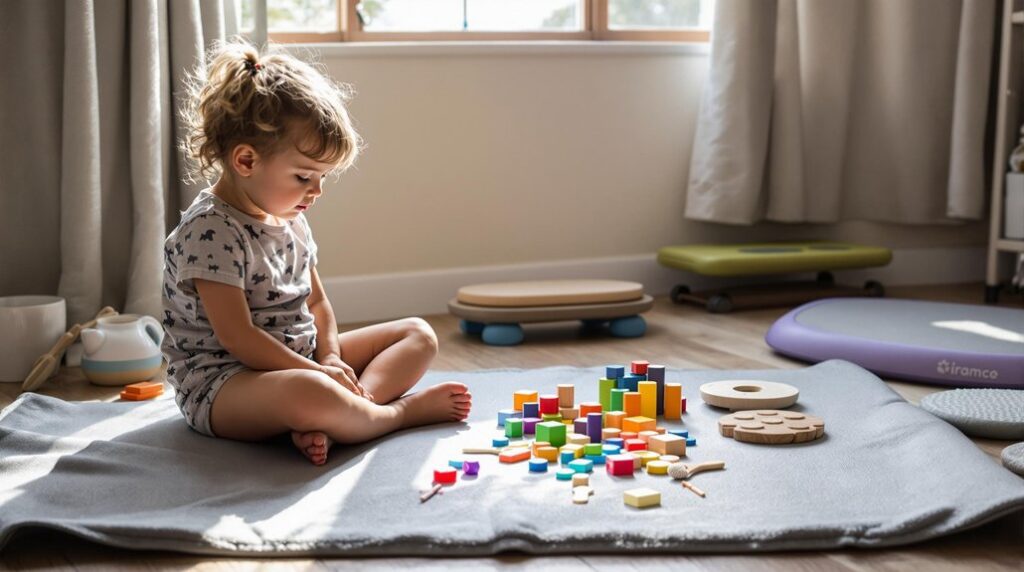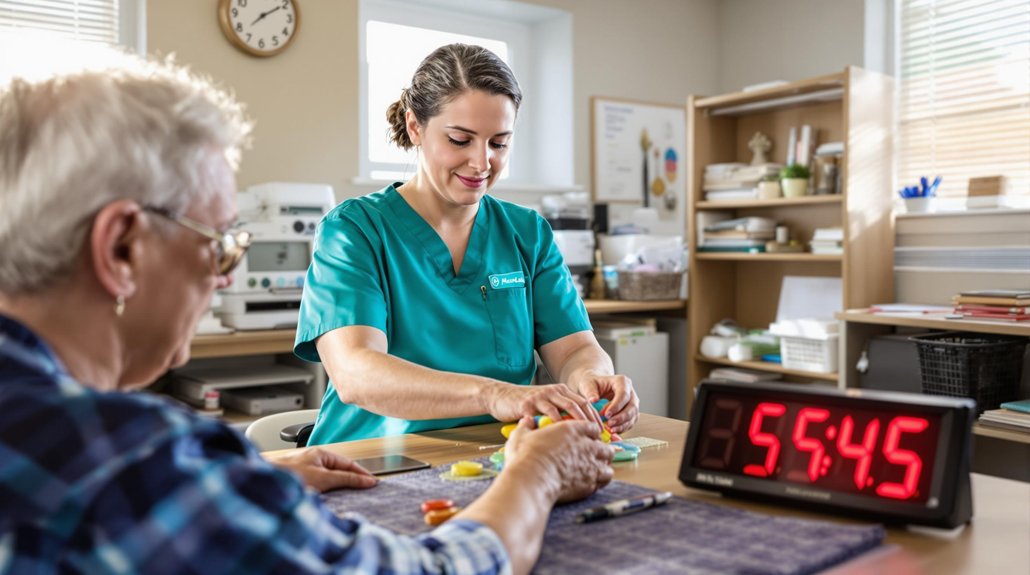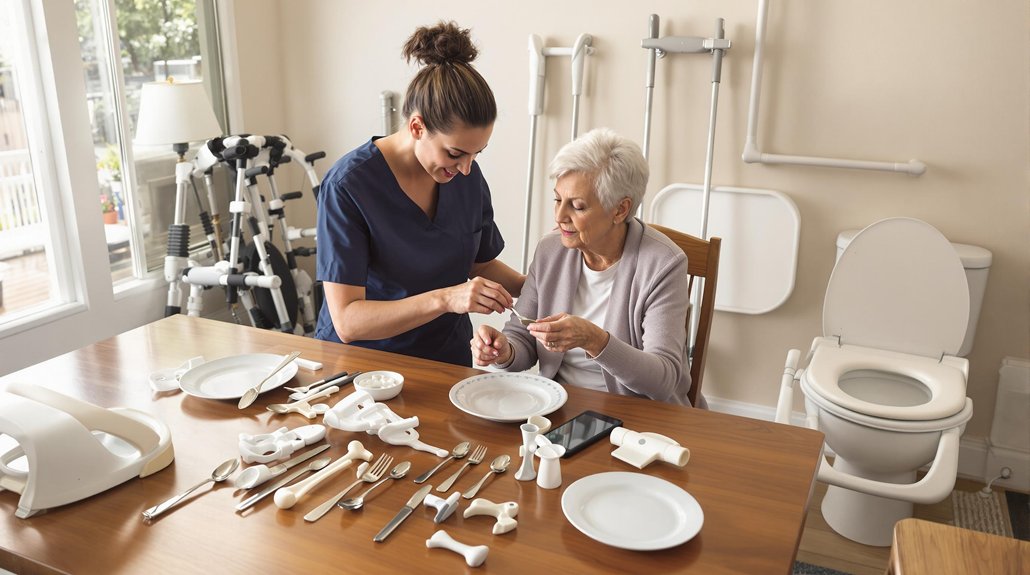You can practice occupational therapy at home by creating a dedicated, distraction-free space with proper lighting and essential tools like therapy putty, stress balls, and resistance bands. Start with basic fine motor activities such as bead threading and puzzle assembly, then progress to daily living skills like meal prep and dressing tasks. Incorporate strengthening exercises using resistance bands and practice proper form. This foundation sets you up to explore more advanced therapeutic techniques.
Setting Up Your Home Therapy Space
Before beginning occupational therapy at home, you’ll need to create a dedicated space that’s both functional and distraction-free. Choose a quiet room or corner with adequate lighting and ventilation.
Consider space organization by removing unnecessary furniture and creating clear pathways for movement activities. Pay attention to sensory considerations when setting up your therapy area.
Select comfortable seating options and use neutral colors that won’t overwhelm the senses. Keep therapy materials organized in labeled containers within easy reach.
Install adjustable lighting to accommodate different activities and sensory needs. Make sure you have enough floor space for physical exercises and a sturdy table for fine motor activities.
Consider using room dividers or screens if you’re working in a shared space to maintain focus during therapy sessions.
Similar to home health therapy, your space should be set up to accommodate both strengthening exercises and functional training activities.
Essential Tools and Equipment for Home OT
A well-equipped home OT therapy space requires specific tools tailored to your therapeutic goals. Start with basic items like therapy putty, stress balls, and resistance bands to improve hand strength and dexterity.
Include sensory tools such as weighted blankets, textured objects, and fidget toys to address sensory processing needs.
Weighted blankets, textured objects, and other sensory tools create a calming environment essential for successful therapeutic outcomes.
For fine motor skills, stock your space with threading beads, puzzles, and writing tools with various grip sizes.
Don’t forget adaptive equipment like built-up handles, specialized scissors, and pencil grips that can make daily tasks easier.
If you’re working on gross motor skills, consider therapy balls, balance boards, and stepping stones.
Keep your tools organized in labeled containers and within easy reach.
Remember to consult your occupational therapist about which specific items will best support your therapy objectives.
Fall prevention strategies are essential components of home occupational therapy to maintain safety and independence while performing daily activities.
Daily Living Skills Exercises
With your tools and equipment ready, practicing daily living skills becomes a natural next step in your home OT journey. Focus on activities that enhance independence and build confidence through repetition and structured practice.
- Incorporate grocery shopping exercises by creating lists, practicing money management, and organizing items by category to improve cognitive and organizational skills.
- Master meal preparation techniques starting with simple recipes, using adaptive utensils when needed, and gradually progressing to more complex cooking tasks while maintaining safety.
- Work on personal care routines like buttoning clothes, tying shoelaces, or using writing tools to strengthen fine motor skills and hand-eye coordination.
Remember to break down each activity into manageable steps and celebrate small victories. Document your progress to help identify areas needing more attention and adjust your exercises accordingly.
Consider working with licensed professionals who can develop personalized care plans to ensure your home therapy exercises align with your specific recovery goals.
Fine Motor Activities You Can Practice
Fine motor activities form the backbone of effective occupational therapy, helping you regain control and dexterity in your hands and fingers.
You’ll strengthen these essential skills through engaging exercises you can do right at home.
Start with simple tasks like paper tearing and playdough sculpting to build grip strength. Progress to bead threading and puzzle assembly to enhance hand-eye coordination.
Challenge yourself with cutting practice using safety scissors and pegboard activities to improve precision. Try finger painting to develop sensory awareness while working those small muscles.
Use tweezers games to refine your pincer grasp, and practice clothespin clip exercises to build finger strength. For an added challenge, try stacking blocks of various sizes.
Remember to start slowly and gradually increase difficulty as your skills improve.
Consider incorporating these activities into your personalized recovery plan to ensure the most effective rehabilitation progress at home.
Strengthening and Mobility Techniques
Building strength and mobility requires a balanced approach combining targeted exercises and functional movements.
A holistic fitness strategy integrates focused strength training with natural movement patterns to build both power and flexibility.
You’ll want to integrate strength exercises and mobility drills into your daily routine to maintain independence and improve overall function.
- Perform resistance band exercises like shoulder pulls, wrist extensions, and ankle rotations to build targeted muscle groups while maintaining joint flexibility.
- Practice weight-bearing activities such as modified push-ups against a wall, countertop lifts, and controlled squats using stable support to enhance functional strength.
- Incorporate dynamic mobility drills including gentle arm circles, controlled knee lifts, and seated trunk rotations to improve range of motion and prevent stiffness.
Focus on proper form and listen to your body’s signals.
Start with manageable repetitions and gradually increase intensity as you build confidence and capability.
Licensed therapists can develop personalized rehabilitation plans to ensure exercises are appropriate for your specific recovery needs.
Cognitive Training Exercises
Physical exercises support your body, but your brain needs regular workouts too. You can enhance cognitive function through engaging activities that challenge your mind while staying in the comfort of your home. Start with memory games like matching cards, recalling sequences, or creating stories to strengthen your recall abilities.
Try puzzle challenges that test different cognitive skills. Crosswords improve vocabulary and language processing, while jigsaw puzzles enhance visual-spatial awareness. Sudoku develops logical thinking and problem-solving abilities.
Mix these activities throughout your day to maintain mental alertness and cognitive flexibility. Create a daily schedule that combines both physical and cognitive exercises.
As you work on these skills, you’ll build confidence in helping others with their cognitive rehabilitation needs while maintaining your own mental sharpness.
Tracking Progress and Setting Goals
Measuring your progress in occupational therapy requires consistent documentation and clear objectives. You’ll need to establish realistic goals and monitor your progress evaluation regularly to guarantee you’re moving in the right direction with your recovery.
- Keep a daily journal to track your activities, noting any challenges and achievements in specific tasks that relate to your goal measurement.
- Set SMART goals (Specific, Measurable, Achievable, Relevant, Time-bound) for each skill you’re working to improve.
- Take photos or videos of your activities to visually document your progress and share with your healthcare provider.
Remember to adjust your goals as needed based on your progress. Working with your occupational therapist, you can modify your home program to match your changing abilities and guarantee continued improvement in your daily activities.
Safety Considerations During Home Practice
Before starting any at-home occupational therapy exercises, you’ll need to prioritize safety to prevent injuries and guarantee effective practice.
Begin by evaluating your space for fall hazards and making necessary environmental modifications, such as removing loose rugs and securing adequate lighting.
Establish clear emergency protocols and keep a phone within reach during exercises.
Determine your supervision needs and don’t hesitate to ask family members for assistance when necessary.
Always inspect equipment safety before use, ensuring tools and adaptive devices are in good condition.
Maintain safe positioning throughout exercises and respect your personal boundaries – don’t push beyond your comfort level.
Consider sensory considerations like temperature, noise, and lighting that might affect your performance.
If you experience pain or discomfort, stop immediately and consult your occupational therapist.
Incorporating OT Into Daily Routines
Successfully integrating occupational therapy into your daily life requires turning therapeutic exercises into natural habits rather than isolated events. By focusing on routine integration, you’ll find more opportunities to practice therapeutic movements throughout your day.
Set daily reminders on your phone or leave notes in strategic locations to help you remember incorporating exercises during regular activities.
- Transform morning self-care tasks into therapy sessions by practicing fine motor skills while buttoning clothes, brushing teeth, or combing hair.
- Use meal preparation time to work on grip strength, coordination, and reaching movements while cooking or setting the table.
- Convert household chores into therapy opportunities by mindfully engaging core muscles during vacuuming, focusing on balance while doing laundry, or practicing grip patterns while gardening.
Conclusion
Home OT therapy can make a real difference in your daily life when you have the right tools and know-how. Picture yourself getting better at tasks that used to be hard – from buttoning a shirt to preparing a meal. Your home can become a place where you practice and grow stronger each day. Every small step forward matters, and you don’t have to do it alone.
Think of your therapy space as a workshop where you build confidence and independence, one exercise at a time. You’re working toward a meaningful goal: being able to do more of what matters to you.
Remember, many others have walked this path before you, and support is always available. Focus Family Care understands your journey and is ready to help you succeed.
If you or a loved one need help, don’t wait. Reach out to Focus Family Care today at (561) 693-1311 or email us at info@focusfamilycare.com.





